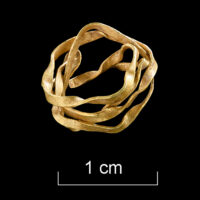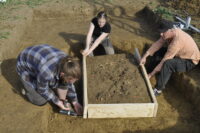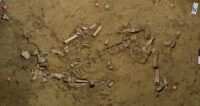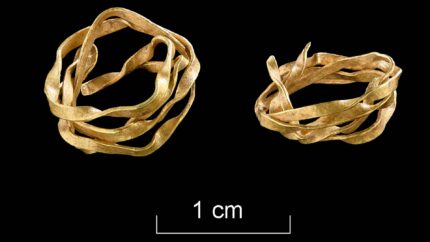 A gold spiral strongly reminiscent of a fettucine nest is the oldest precious metal object ever discovered in southwest Germany. It was unearthed last fall in the grave of a Bronze Age woman near the town of Ammerbuch-Reusten. The burial contained the skeletal remains of an adult woman buried in fetal position. Archaeologists found a single object: a small spiral ring made of gold wire. It was located about hip height and is believed to have been a hair ornament.
A gold spiral strongly reminiscent of a fettucine nest is the oldest precious metal object ever discovered in southwest Germany. It was unearthed last fall in the grave of a Bronze Age woman near the town of Ammerbuch-Reusten. The burial contained the skeletal remains of an adult woman buried in fetal position. Archaeologists found a single object: a small spiral ring made of gold wire. It was located about hip height and is believed to have been a hair ornament.
 Archaeologists and students from the University of Tübingen and the Baden-Württemberg State Office for Monument Preservation removed the grave, bones and gold spiral, in a soil block for excavation and analysis in the laboratory. Radiocarbon dating of her bones dates the burial to between about 1850 and 1700 B.C., the Early Bronze Age.
Archaeologists and students from the University of Tübingen and the Baden-Württemberg State Office for Monument Preservation removed the grave, bones and gold spiral, in a soil block for excavation and analysis in the laboratory. Radiocarbon dating of her bones dates the burial to between about 1850 and 1700 B.C., the Early Bronze Age.
The gold in the ring was composed of about 20% silver, less than 2% copper,  traces of platinum and tin. This composition indicates the gold was alluvial in origin and the proportions points to the alloy’s source as the River Carnon in Conrnwall. The raw material from previous gold objects found in Europe from this period and earlier originated from southeastern Europe, so the spiral is remarkably early evidence of an expansive trade network in luxury goods in northwestern Europe.
traces of platinum and tin. This composition indicates the gold was alluvial in origin and the proportions points to the alloy’s source as the River Carnon in Conrnwall. The raw material from previous gold objects found in Europe from this period and earlier originated from southeastern Europe, so the spiral is remarkably early evidence of an expansive trade network in luxury goods in northwestern Europe.
The research team evaluates the new gold find from Ammerbuch-Reusten as evidence that Western cultural groups gained growing influence on Central Europe in the first half of the second millennium before our time. The women’s grave was not far from a group of other burials from the Early Bronze Age and is evidently related to the well-known hilltop settlement on the nearby Reustener Kirchberg.
